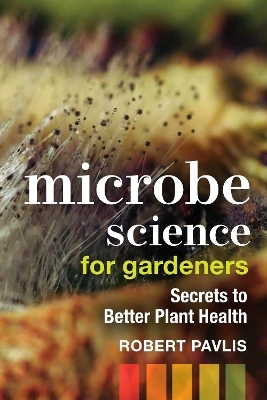
Microbe Science for Gardeners
New Society Publishers (Verlag)
978-0-86571-977-4 (ISBN)
Useful and practical gardening advice.
–Jeff Lowenfels, author, the Teaming Series and DIY Autoflowering Cannabis
Microscopic organisms are as important to plant growth as water and light. Microbe Science for Gardeners highlights the essential role of microbes in plant biosystems and soil health, providing practical how-to gardening advice for enhancing plant microbiomes, and debunking common gardening myths.
Going beyond soil biology to examine the crucial role of microorganisms in cultivating a productive garden, this accessible guide covers:
The interrelationships in microbe populations and between microbes and plants
Understanding microbes such as bacteria, yeast, mycorrhizal fungi, and protozoa, both in the rhizosphere and above ground
How common practices such as tilling, crop rotation, and mulching affect the microbe community
How the savvy gardener can encourage beneficial microorganisms while discouraging those that cause disease or other undesirable effects
An objective analysis of popularized practices such as controlling fungal-to- bacterial ratios and applying biostimulants, compost tea, or plant probiotics
Prevention and cures for dozens of bacterial, viral, and fungal plant diseases.
Whether you're a home gardener, market gardener, or micro-farmer, Microbe Science for Gardeners will help you leverage the incredible power of the mighty microbe to grow healthy, strong, thriving plants.
Robert Pavlis is a Master Gardener with over 45 years' experience in the art and science of horticulture, with a particular focus on soil chemistry and health. He is the owner and developer of Aspen Grove Gardens, a 6-acre botanical garden featuring 3,000 varieties of plants. A sought-after speaker, and lecturer, Robert has published many articles in magazines such as Mother Earth News and Ontario Gardening. He maintains two widely read blogs – gardenfundamentals.com and gardenmyths.com – and a popular YouTube channel with tens of thousands of subscribers. Robert is the author of Compost Science for Gardeners, Plant Science for Gardeners, Soil Science for Gardeners, and Building Natural Ponds. He lives in Guelph, Canada.
1. Introduction
Why Learn About Microbes?
Terms Used in This Book
2. The World Under a Microscope
Microbes by the Numbers
Microbes Are Important to Plants
Microbes Can Harm Plants
Gardeners Affect Microbes
How Do Microbes Move Around?
How Much Do We Really Know?
3. Bacteria
How Do Bacteria Eat?
Where Do Bacteria Live?
Life Cycle of Bacteria
Nitrogen-Fixing Bacteria
4. Fungi
What do Fungi Eat?
Where Do Fungi Live?
Life Cycle of Fungi
Pathogenic Fungi
Mycorrhizal Fungi
5. Yeast
Life Cycle of Yeast
Yeast-Plant Interactions
Yeast in Hellebore Nectar
Yeast Creates Alcoholics
Yeast on Leaves
Yeast in Soil
A Bioindicator of Air Quality
A Possible Solution to Plastic Pollution
6. Nematodes
7. Protozoa
Life Cycle of Protozoa
Nutrient Cycling
Protozoa-Plant Interactions
Plant Diseases
8. Viruses
Viruses in Soil
Life Cycle of a Virus
The Spread of Viruses
Virus Infection of Microbes
Virus Infection of Plants
Rapid Mutation
Beneficial Interaction with Plants
9. More Microbes
Archaea
Actinomycetes
Cyanobacteria
Algae
10. Microbe Communities
Microbe Communities and Microbiomes
Signaling Between Microbes
Microbes Attack Microbes
Mycorrhizal Interactions
Lichens
11. Plants Love Microbes
Nutrient Availability
The Phyllosphere
Rhizosphere
Rhizophagy Cycle
Seed Microbiome
12. Manipulating Microbes
Fungal-to-Bacterial Ratio
Effect of Agriculture
Biodiversity
13. Bioinoculants for the Garden
Bioinoculants for Seeds
Bioinoculants as a Foliar Spray
Bioinoculants for Soil
Microbes Are No Longer Living
Should Gardeners Use Commercial Bioinoculants?
Compost Tea
14. Pathogens
You Suspect a Disease—What Now?
List of Plant Diseases
Fighting Plant Diseases
Commercial Pesticides
Human Diseases
Endnotes
Index
About the Author
Also by the Author
About New Society Publishers
| Erscheinungsdatum | 06.03.2023 |
|---|---|
| Reihe/Serie | Garden Science Series |
| Zusatzinfo | 25 Illustrations, black and white |
| Verlagsort | Gabriola Island |
| Sprache | englisch |
| Maße | 152 x 229 mm |
| Gewicht | 304 g |
| Themenwelt | Sachbuch/Ratgeber ► Gesundheit / Leben / Psychologie |
| Sachbuch/Ratgeber ► Natur / Technik ► Garten | |
| Naturwissenschaften ► Biologie ► Mikrobiologie / Immunologie | |
| ISBN-10 | 0-86571-977-2 / 0865719772 |
| ISBN-13 | 978-0-86571-977-4 / 9780865719774 |
| Zustand | Neuware |
| Informationen gemäß Produktsicherheitsverordnung (GPSR) | |
| Haben Sie eine Frage zum Produkt? |
aus dem Bereich


